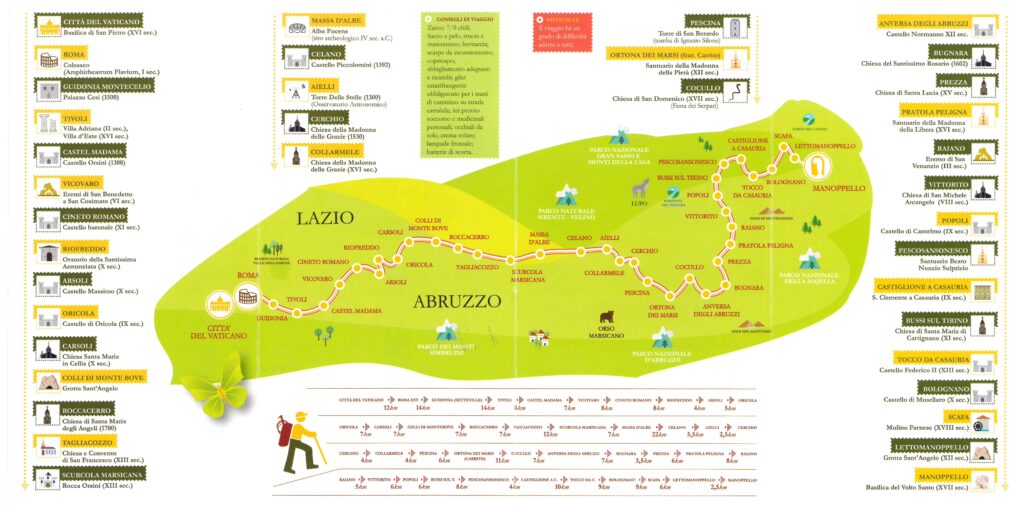
The path of the “Pilgrim’s Way” is marked by stages that pass through places of extraordinary beauty and spiritual richness. Each stage is designed not only as a part of the journey towards the Holy Face but also as an opportunity for reflection and personal discovery. Along the way, travelers encounter historical sites, natural landscapes, and communities that offer hospitality, enriching the pilgrim’s experience with their culture and traditions. Each stage represents a unique chapter in a larger story that unfolds with each step toward the destination.
The Pilgrim’s Way weaves through a mosaic of Italian landscapes and towns, starting from Rome and embracing the cultural and natural wealth of numerous towns in Lazio and Abruzzo. The stages are designed to highlight each area traversed, showcasing the beauty and unique spirit of every location, from small villages to larger towns, culminating in the spiritual destination of Manoppello.
The path, which can be traveled on foot, by bicycle, or on horseback, spans 30 towns and is dotted with historical monuments, fortified villages, and castles such as those in Avezzano and Scurcola Marsicana, the Sangro Castle in Anversa degli Abruzzi, the Piccolomini Castle in Celano, the Castle of Ortona dei Marsi, the De Sanctis Castle in Roccacasale, the Castle of Carsoli, the Musellaro Castle in Bolognano, the Cantelmo Castle in Popoli, and the Tocco da Casauria Castle. The path also crosses four parks and numerous natural reserves, rich in stunning landscapes. Equally fascinating are the archaeological sites, hermitages, and caves like those of Sant’Angelo in Carsoli, Castiglione a Casauria and Lettomanoppello, San Marco alla Foce in Celano, San Venanzio in Raiano, Santa Croce al Morrone, Santa Maria al Morrone, and Sant’Onofrio near Sulmona. Along the journey, numerous traces of the ancient transhumance routes and architectural highlights of Benedictine and Cistercian monasticism can be seen, such as S. Clemente a Casauria in Castiglione a Casauria, S. Maria D’Arabona in Manoppello, San Giovanni Battista in Celano, Santa Maria della Vittoria in Scurcola Marsicana, San Francesco in Tagliacozzo, Santa Maria di Cartignano in Bussi sul Tirino, and San Nicola in Pescosansonesco.
The Pilgrim’s Way stands out for its uniqueness, offering the freedom to travel in complete autonomy. Each stage is planned to end near railway stations, allowing pilgrims to customize their itinerary according to their own pace and interests, choosing where to begin and end their spiritual journey. This flexibility makes it ideal for those seeking a deeply personal and tailor-made experience.
Click on each stage to view detailed information, including maps, refreshment points, and accommodations.
Optional Stage 0 – no marked by totems
- Roma RM
Stage 1
- Guidonia Monticelio RM
- Tivoli RM
Step 2
- Castel Madama RM
- Vicovaro RM
Stage 3
- Vicovaro
- Bivio di Cineto Romano
- Anticoli Corrado RM
- Roviano RM
- Arsoli RM
Stage 4
- Arsoli RM
- Carsoli AQ
Stage 5
- Carsoli
- Colle di Monte Bove AQ
- Rocca Cerro AQ
- Tagliacozzo AQ
Stage 6
- Tagliacozzo
- Scurcola Marsicana AQ
- Cappelle Dei Marsi AQ
- Antrosano AQ
- Alba Fucens AQ
- Massa D’Albe AQ
Stage 7
- Massa D’Albe AQ
- Ovindoli AQ
- Celano AQ
- Aielli AQ
- Cerchio AQ
- Collarmele AQ
Stage 8
- Pescina AQ
- Ortona Dei Marsi AQ
- Cocullo AQ
Stage 9
- Anversa Degli Abruzzi AQ
- Bugnara AQ
- Prezza AQ
- Pratola Peligna AQ
Stage 10
- Raiano AQ
- Vittorito PE
- Popoli PE
- Bussi Sul Tirino PE
Stage 11
- Pescosansonesco PE
- Castiglione A Casauria PE
- Tocco Da Casauria PE